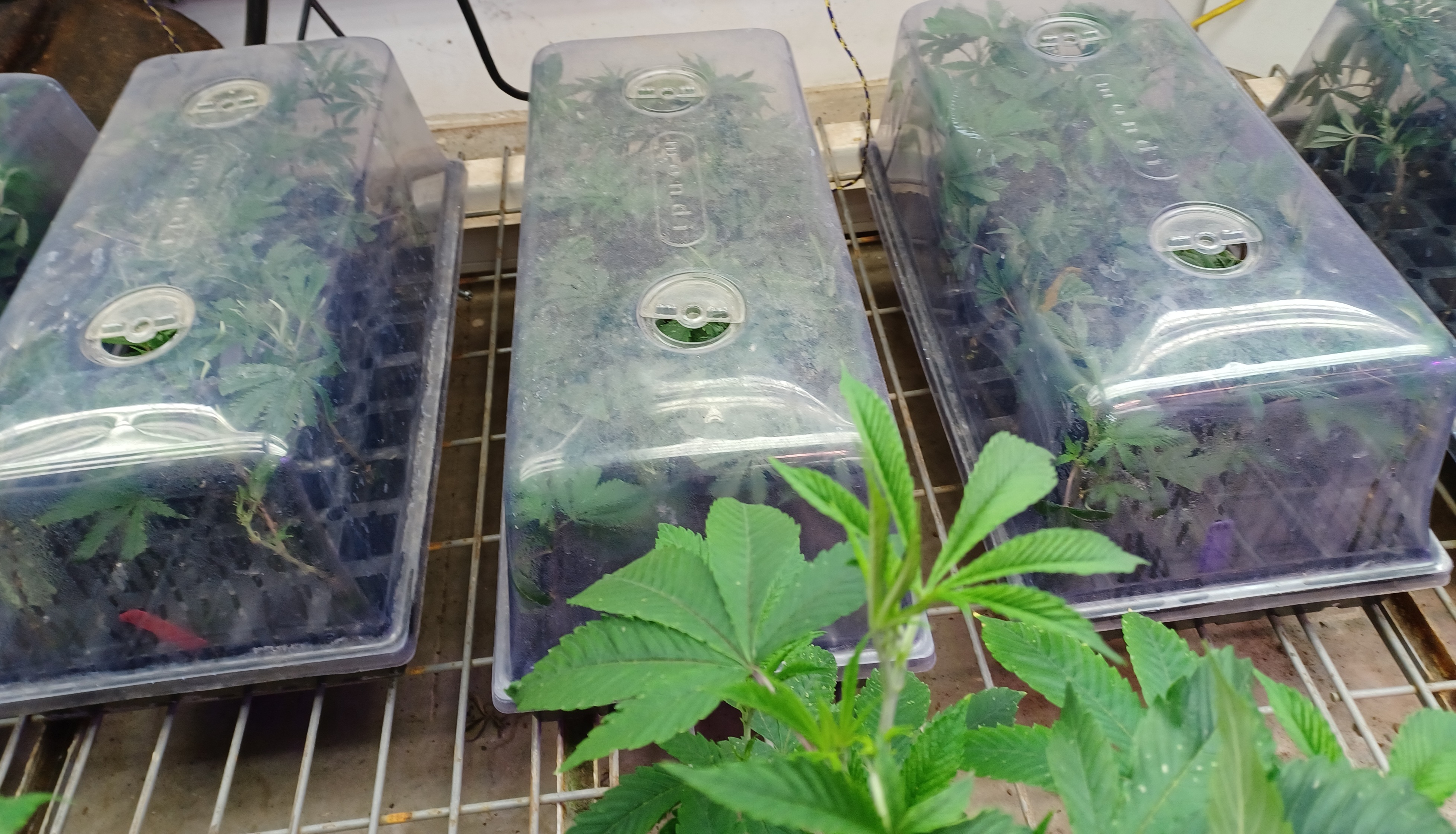|
Autoflowering Cannabis
Autoflowering cannabis or day neutral cannabis varieties automatically switch from vegetative growth to the flowering stage based on age, as opposed to the ratio of light to dark hours required with photoperiod dependent/short-day strains. Many autoflowering varieties are ready to harvest in less than 10 weeks from seed. Dwarf varieties can have short stature while still giving decent harvests. Origins The origins of autoflowering cannabis are still debatable. The strain Lowryder by breeder The Joint Doctor was the original large scale marketed autoflower. Lowryder contains genetics from a Mexican strain that was referred to as Mexican Rudy and is believed to be created from a cross between a Mexican sativa and a Russian Cannabis ruderalis. Another theory is that the early genetics came from the first oilseed hemp variety called Finola, which was developed from Russian stock in Finland during 1995. These early hybrids with large amounts of C. ruderalis genes were lacking so ... [...More Info...] [...Related Items...] OR: [Wikipedia] [Google] [Baidu] |
Photoperiodism
Photoperiodism is the physiological reaction of organisms to the length of night or a dark period. It occurs in plants and animals. Plant photoperiodism can also be defined as the developmental responses of plants to the relative lengths of light and dark periods. They are classified under three groups according to the photoperiods: short-day plants, long-day plants, and day-neutral plants. Plants Many flowering plants (angiosperms) use a photoreceptor protein, such as phytochrome or cryptochrome, to sense seasonal changes in night length, or photoperiod, which they take as signals to flower. In a further subdivision, ''obligate'' photoperiodic plants absolutely require a long or short enough night before flowering, whereas ''facultative'' photoperiodic plants are more likely to flower under one condition. Phytochrome comes in two forms: Pr and Pfr. Red light (which is present during the day) converts phytochrome to its active form (pfr). This then triggers the plant to grow. ... [...More Info...] [...Related Items...] OR: [Wikipedia] [Google] [Baidu] |
Cannabis Ruderalis
''Cannabis ruderalis'' is a variety, subspecies, or species of ''Cannabis'' native to Central and Eastern Europe and Russia. It contains a relatively low quantity of psychoactive compound tetrahydrocannabinol (THC) Some scholars accept ''C. ruderalis'' as its own species due to its unique traits and phenotypes which distinguish it from '' C. indica'' and '' C. sativa''; others debate whether ''ruderalis'' is a subdivision under ''C. sativa''. The consensus among plant taxonomical databases, as of 2022, is to consider it ''Cannabis sativa'' var. ''ruderalis''. Description ''Cannabis ruderalis'' is smaller than other species of ''Cannabis'', rarely growing over in height. According to one source, the plants have "thin, slightly fibrous stems" with little branching. The foliage is typically open with large leaves. ''C. ruderalis'' reaches maturity much quicker than other species of ''Cannabis,'' typically 5–7 weeks after being planted from seed. Unli ... [...More Info...] [...Related Items...] OR: [Wikipedia] [Google] [Baidu] |
Breeders
A breeder is a person who selectively breeds carefully selected mates, normally of the same breed to sexually reproduce offspring with specific, consistently replicable qualities and characteristics. This might be as a farmer, agriculturalist, or hobbyist, and can be practiced on a large or small scale, for food, fun, or profit. About A breeder can breed purebred pets such as cats or dogs, livestock such as cattle or horses, and may show their animals professionally in assorted forms of competitions In these specific instances, the breeder strives to meet standards in each animal set out by organizations. A breeder may also assist with breeding animals in the zoo. In other cases, a breeder can be referred to an animal scientist who has the capabilities of developing more efficient ways to produce the meat and other animal products humans eat. Earnings as a breeder vary widely because of the various types of work involved in the job title. Even in breeding small domestic animals ... [...More Info...] [...Related Items...] OR: [Wikipedia] [Google] [Baidu] |
Cannabidiol
Cannabidiol (CBD) is a phytocannabinoid discovered in 1940. It is one of 113 identified cannabinoids in cannabis plants, along with tetrahydrocannabinol (THC), and accounts for up to 40% of the plant's extract. , clinical research on CBD included studies related to anxiety, cognition, movement disorders, and pain, but there is insufficient high-quality evidence that cannabidiol is effective for these conditions. Nevertheless, CBD is an herbal dietary supplement promoted with unproven claims of particular therapeutic effects. The global market size for CBD was predicted to exceed billion by 2028. Cannabidiol can be taken internally in multiple ways, including by inhaling cannabis smoke or vapor, oral, and as an aerosol spray into the cheek. It may be supplied as CBD oil containing only CBD as the active ingredient (excluding tetrahydrocannabinol HCor terpenes), CBD-dominant hemp extract oil, capsules, dried cannabis, or prescription liquid solution. CBD does not have the ... [...More Info...] [...Related Items...] OR: [Wikipedia] [Google] [Baidu] |
Cannabis Cultivation
This article presents common techniques and facts regarding the cultivation of cannabis, primarily for the production and consumption of its infructescences ("buds" or "flowers"). Cultivation techniques for other purposes (such as hemp production) differ. Botany Cannabis belongs to the genus ''Cannabis'' in the family Cannabaceae. It may include three species, ''Cannabis indica'', '' C. sativa'', and '' C. ruderalis'' (APG II system), or one variable species. It is typically a dioecious (each individual is either male or female) annual plant. ''C. sativa'' and ''C. indica'' generally grow tall, with some varieties reaching 4 metres, or 13 feet. Female plants produce tetrahydrocannabinol (THC) (up to 31% by weight) as the season changes from summer to autumn. ''C. ruderalis'' is very short, produces only trace amounts of THC, but is very rich in cannabidiol (CBD) an antagonist to THC, which may be 40% of the cannabinoids in a plant. C. ruderalis flowers independently ... [...More Info...] [...Related Items...] OR: [Wikipedia] [Google] [Baidu] |


.jpg)

